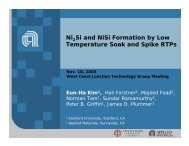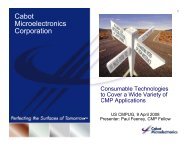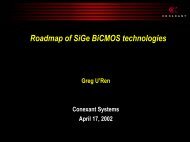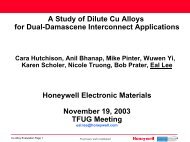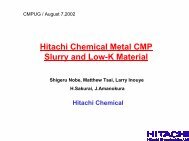Nanowires of four epitaxial hexagonal silicides grown on Siâ001â¦
Nanowires of four epitaxial hexagonal silicides grown on Siâ001â¦
Nanowires of four epitaxial hexagonal silicides grown on Siâ001â¦
Create successful ePaper yourself
Turn your PDF publications into a flip-book with our unique Google optimized e-Paper software.
3216 J. Appl. Phys., Vol. 91, No. 5, 1 March 2002 Chen, Ohlberg, WilliamsFIG. 4. a Average widths vs large lattice mismatches, b average heightsvs large lattice mismatches, and c average lengths vs small lattice mismatches,respectively, <str<strong>on</strong>g>of</str<strong>on</strong>g> ScSi 2 , ErSi 2 , DySi 2 , and GdSi 2 nanowires al<strong>on</strong>g110 Si and 11¯0 Si directi<strong>on</strong>s, respectively. The variati<strong>on</strong> ranges <str<strong>on</strong>g>of</str<strong>on</strong>g> thenanowire sizes are shown by error bars, which represent standard deviati<strong>on</strong>s <str<strong>on</strong>g>of</str<strong>on</strong>g> the data.higher magnificati<strong>on</strong>, and are shown as a functi<strong>on</strong> <str<strong>on</strong>g>of</str<strong>on</strong>g> theappropriate lattice mismatch in Fig. 4. As shown in Figs. 4aand 4b, the average widths and heights <str<strong>on</strong>g>of</str<strong>on</strong>g> the nanowiresdecreased m<strong>on</strong>ot<strong>on</strong>ically as the absolute values <str<strong>on</strong>g>of</str<strong>on</strong>g> the latticemismatches al<strong>on</strong>g the width directi<strong>on</strong> increases. However,there was no simple relati<strong>on</strong> between the average lengths <str<strong>on</strong>g>of</str<strong>on</strong>g>the nanowires and the lattice mismatches al<strong>on</strong>g the lengthdirecti<strong>on</strong>, as shown in Fig. 4c.High-resoluti<strong>on</strong> STM images <str<strong>on</strong>g>of</str<strong>on</strong>g> ScSi 2 , ErSi 2 , DySi 2 ,and GdSi 2 nanowires are shown in Fig. 5. The lattice spacings<strong>on</strong> all the nanowire surfaces al<strong>on</strong>g their length directi<strong>on</strong>sagree with the value <str<strong>on</strong>g>of</str<strong>on</strong>g> the atomic spacing al<strong>on</strong>g110 Si directi<strong>on</strong>s <strong>on</strong> the Si001 surface, 0.384 nm, withinthe measurement uncertainties. The observed periodic structures<strong>on</strong> the top surfaces <str<strong>on</strong>g>of</str<strong>on</strong>g> the nanowires agree well with a‘‘2n’’ rec<strong>on</strong>structi<strong>on</strong> <str<strong>on</strong>g>of</str<strong>on</strong>g> a slightly distorted silicide surface,where n varies for the different <str<strong>on</strong>g>silicides</str<strong>on</strong>g>, and thus the silicidelattices appear to be elastically strained to fit the Si substratein the width directi<strong>on</strong>. No dislocati<strong>on</strong>s were observed in theSTM images <str<strong>on</strong>g>of</str<strong>on</strong>g> the nanowires <str<strong>on</strong>g>grown</str<strong>on</strong>g> under the growth c<strong>on</strong>diti<strong>on</strong>sspecified above. The top and the edges <str<strong>on</strong>g>of</str<strong>on</strong>g> the nanowiresare usually atomically smooth except for occasi<strong>on</strong>alpoint defects mainly vacancies. The lattice mismatch alsoinfluenced the shape <str<strong>on</strong>g>of</str<strong>on</strong>g> the nanowires. As shown in Fig. 5a,the ScSi 2 nanowires usually have a trapezoidal cross secti<strong>on</strong>with sidewall slopes in the range 15°–21°. For the <str<strong>on</strong>g>silicides</str<strong>on</strong>g>in compressi<strong>on</strong>, the nanowires have larger width to heightratios with a (11¯00) plane defining the top surface, but theirshape does change with increasing lattice mismatch. TheScSi 2 , ErSi 2 , and DySi 2 nanowires always grew <strong>on</strong> the top<str<strong>on</strong>g>of</str<strong>on</strong>g> a Si terrace, but some secti<strong>on</strong>s <str<strong>on</strong>g>of</str<strong>on</strong>g> GdSi 2 nanowires grewinto a Si terrace and appeared to be slightly below the level<str<strong>on</strong>g>of</str<strong>on</strong>g> the surrounding Si as detected by STM Fig. 5d.Figure 6 displays the wide variety <str<strong>on</strong>g>of</str<strong>on</strong>g> GdSi 2 nanowireenvir<strong>on</strong>ments, which provide some clues for the nanowiregrowth. Some atoms were observed to align into atomicstrings, as labeled A1–A4, which may be the nuclei forGdSi 2 nanowires. The strings were single or double atomicrows with lengths less than 15 nm. They were distributedrandomly al<strong>on</strong>g the two perpendicular 110 Si directi<strong>on</strong>s <strong>on</strong>the Si terraces A1 and A2 or at Si step edges A3 and A4.The nanowires themselves were always oriented al<strong>on</strong>g <strong>on</strong>e <str<strong>on</strong>g>of</str<strong>on</strong>g>the two perpendicular 110 Si directi<strong>on</strong>s and based <strong>on</strong> asingle terrace. They could grow entirely <strong>on</strong> the top <str<strong>on</strong>g>of</str<strong>on</strong>g> a Siterrace e.g., the nanowire B1. When the end <str<strong>on</strong>g>of</str<strong>on</strong>g> a growingnanowire approached a Si step, it did not change directi<strong>on</strong> t<str<strong>on</strong>g>of</str<strong>on</strong>g>ollow the original Si step edge, but rather the step c<strong>on</strong>formedto the nanowire e.g., the Si step al<strong>on</strong>g the nanowireC1 and/or retreated from the advancing nanowires Si stepsat the end <str<strong>on</strong>g>of</str<strong>on</strong>g> the nanowires C3 and C4. Such step/nanowireinteracti<strong>on</strong>s were also observed for ScSi 2 , ErSi 2 , and DySi 2see Fig. 3. However, GdSi 2 nanowires were unique in thatwhen some approached Si steps, they could cut into thehigher Si terrace and form secti<strong>on</strong>s <str<strong>on</strong>g>of</str<strong>on</strong>g> GdSi 2 nanowire embeddedwithin the terraces e.g., nanowires C1–C4. In thiscase, the apparent height sensed by STM <str<strong>on</strong>g>of</str<strong>on</strong>g> the nanowirewas lower than the surrounding Si.III. DISCUSSIONThe size and shape <str<strong>on</strong>g>of</str<strong>on</strong>g> the self-assembled nanowires isstr<strong>on</strong>gly influenced by their asymmetric lattice mismatcheswith respect to the Si lattice. All the <str<strong>on</strong>g>silicides</str<strong>on</strong>g> studied herehave the AlB 2 <str<strong>on</strong>g>hexag<strong>on</strong>al</str<strong>on</strong>g> crystal structure. 14–21 Based <strong>on</strong> theknown crystallographic orientati<strong>on</strong> <str<strong>on</strong>g>of</str<strong>on</strong>g> silicide thin films withrespect to a Si001 substrate and the interfacial structuresproposed in Ref. 13, the relative orientati<strong>on</strong>s <str<strong>on</strong>g>of</str<strong>on</strong>g> the bulkatomic structures <str<strong>on</strong>g>of</str<strong>on</strong>g> the silicide and Si crystals are illustratedin Fig. 7. ScSi 2 , ErSi 2 , DySi 2 , and GdSi 2 , have large latticeDownloaded 08 Mar 2003 to 192.6.19.190. Redistributi<strong>on</strong> subject to AIP license or copyright, see http://ojps.aip.org/japo/japcr.jsp
J. Appl. Phys., Vol. 91, No. 5, 1 March 2002 Chen, Ohlberg, Williams3217FIG. 6. Color STM topograph (200 nm200 nm) showing GdSi 2 nanowires<str<strong>on</strong>g>grown</str<strong>on</strong>g> <strong>on</strong> Si001. The substrate slopes downward from top right tobottom left in the order <str<strong>on</strong>g>of</str<strong>on</strong>g> red, green, blue with Si terraces <str<strong>on</strong>g>of</str<strong>on</strong>g> differentheights separated by single atomic steps. The short silicide atomic stringsare marked by A1–A4. The nanowire B1 is <strong>on</strong> the top <str<strong>on</strong>g>of</str<strong>on</strong>g> a Si terrace. Thetop left secti<strong>on</strong>s <str<strong>on</strong>g>of</str<strong>on</strong>g> the nanowires C1 and C2 are <strong>on</strong> the top <str<strong>on</strong>g>of</str<strong>on</strong>g> the lower Siterraces, while the bottom right secti<strong>on</strong>s impinge into Si terraces. The secti<strong>on</strong>s<str<strong>on</strong>g>of</str<strong>on</strong>g> nanowires C3 and C4 shown here are completely incorporatedwithin their Si terraces.mismatches 4.6%, 6.3%, 7.6%, and 8.9%, respectivelyal<strong>on</strong>g 0001 silicide and <strong>on</strong>e <str<strong>on</strong>g>of</str<strong>on</strong>g> the 110 Si directi<strong>on</strong>s andmuch smaller lattice mismatches 0.8%, 1.6%, 0.1%, and0.8%, respectively al<strong>on</strong>g the perpendicular 112¯0 silicide and110 Si directi<strong>on</strong>s. To minimize the strain energy, the silicidecrystals grow preferentially al<strong>on</strong>g the 112¯0 silicide directi<strong>on</strong>,leading to the formati<strong>on</strong> <str<strong>on</strong>g>of</str<strong>on</strong>g> el<strong>on</strong>gated silicide wires.The tendency for the asymmetric growth increases withthe large lattice mismatch al<strong>on</strong>g the width (0001 silicide ) directi<strong>on</strong>increasing in the order <str<strong>on</strong>g>of</str<strong>on</strong>g> ScSi 2 , ErSi 2 , DySi 2 , andGdSi 2 , resulting in the widths and heights <str<strong>on</strong>g>of</str<strong>on</strong>g> the nanowiresFIG. 5. Color High-resoluti<strong>on</strong> STM topographs showing secti<strong>on</strong>s <str<strong>on</strong>g>of</str<strong>on</strong>g> a a ScSi 2nanowire width: 13.05 nm, height: 1.79 nm, b an ErSi 2 nanowire width: 4.69 nm,height: 0.70 nm, c a DySi 2 nanowire width: 4.83 nm, height: 0.56 nm, d a GdSi 2nanowire width: 3.27 nm, height: 0.05 nm, below the Si terrace, as determined bySTM, which resp<strong>on</strong>ds to both geometrical and electr<strong>on</strong>ic structure differences.FIG. 7. Schematic diagram illustrating the projected relative positi<strong>on</strong>s <str<strong>on</strong>g>of</str<strong>on</strong>g> Siatoms in a silicide with an AlB 2 structure and in an unrec<strong>on</strong>structed Si001surface not drawn to scale. At an actual interface, the silicide atoms locatingnext to the interface will be strained.Downloaded 08 Mar 2003 to 192.6.19.190. Redistributi<strong>on</strong> subject to AIP license or copyright, see http://ojps.aip.org/japo/japcr.jsp
3218 J. Appl. Phys., Vol. 91, No. 5, 1 March 2002 Chen, Ohlberg, Williamsdecrease m<strong>on</strong>ot<strong>on</strong>ically with increasing absolute value <str<strong>on</strong>g>of</str<strong>on</strong>g> thelarge lattice mismatch al<strong>on</strong>g the width (0001 silicide ) directi<strong>on</strong>see Fig. 4. Since strain energy is proporti<strong>on</strong>al to thesquare <str<strong>on</strong>g>of</str<strong>on</strong>g> the lattice mismatch, <strong>on</strong>e might naively expect thelength to width aspect ratio <str<strong>on</strong>g>of</str<strong>on</strong>g> the nanowires to vary with thesquare <str<strong>on</strong>g>of</str<strong>on</strong>g> ratio <str<strong>on</strong>g>of</str<strong>on</strong>g> the large to the small lattice mismatch foreach silicide. However, there is no such correlati<strong>on</strong>, and Fig.4c shows that there is not a str<strong>on</strong>g relati<strong>on</strong>ship betweensmall lattice mismatch and average nanowire length. In fact,ScSi 2 appears to lie well outside the behavior <str<strong>on</strong>g>of</str<strong>on</strong>g> the other<str<strong>on</strong>g>silicides</str<strong>on</strong>g> when c<strong>on</strong>sidering nanowire length, which may berelated to the fact that this silicide is in tensi<strong>on</strong> rather thancompressi<strong>on</strong> in the width directi<strong>on</strong>.Although it is energetically favorable to form silicidenanowires by the reacti<strong>on</strong> between deposited metal adatomsand Si atoms <strong>on</strong> the substrate, kinetically this reacti<strong>on</strong> mustbreak Si–Si b<strong>on</strong>ds at the substrate surface. High temperaturesand/or l<strong>on</strong>g annealing times can ensure complete reacti<strong>on</strong><str<strong>on</strong>g>of</str<strong>on</strong>g> the metal, but dislocati<strong>on</strong>s will be introduced into thesilicide crystals to relieve the lattice mismatch strain. Theintroducti<strong>on</strong> <str<strong>on</strong>g>of</str<strong>on</strong>g> dislocati<strong>on</strong>s into the <str<strong>on</strong>g>epitaxial</str<strong>on</strong>g> nanocrystalsrelieves the asymmetric lattice mismatch, resulting in coarseningand/or fragmentati<strong>on</strong> <str<strong>on</strong>g>of</str<strong>on</strong>g> the nanowires. Since, the optimumtemperature window for dislocati<strong>on</strong>-free nanowiregrowth is relatively low, 575–620 °C, the most likely source<str<strong>on</strong>g>of</str<strong>on</strong>g> Si atoms to react with the deposited metal is step edges,because <str<strong>on</strong>g>of</str<strong>on</strong>g> the lower number <str<strong>on</strong>g>of</str<strong>on</strong>g> Si–Si b<strong>on</strong>ds. 13,25 The arrangement<str<strong>on</strong>g>of</str<strong>on</strong>g> the nanowires and Si steps after growth indicatesthat when the leading end <str<strong>on</strong>g>of</str<strong>on</strong>g> a growing nanowire approachesa Si step, the step retreats from the advancingnanowire. The original Si steps are deformed to c<strong>on</strong>form tothe nanowires, which creates a ‘‘snowplow’’ effect, causingsuccessive step edges to bunch up ahead <str<strong>on</strong>g>of</str<strong>on</strong>g> the nanowire seeFigs. 3 and 6. The average terrace widths <strong>on</strong> the Si001substrate before depositi<strong>on</strong> al<strong>on</strong>g 110 Si and 11¯0 Si were57.8 and 21.3 nm, respectively, and all the steps were <strong>on</strong>eatom high see Fig. 2. The average lengths <str<strong>on</strong>g>of</str<strong>on</strong>g> the nanowiresal<strong>on</strong>g 110 Si and 11¯0 Si see Fig. 4c were significantlyl<strong>on</strong>ger except for ScSi 2 , which were <strong>on</strong>ly slightly l<strong>on</strong>gerthan the original terrace widths al<strong>on</strong>g 110 Si and 11¯0 Si ,respectively, which dem<strong>on</strong>strates that the growth <str<strong>on</strong>g>of</str<strong>on</strong>g> thenanowires cannot be limited by a single Si atomic step. Thegrowth <str<strong>on</strong>g>of</str<strong>on</strong>g> the nanowires is either terminated by intersecting aperpendicular nanowire or by reaching a step bunch that istoo large to dissociate. The GdSi 2 nanowires <strong>on</strong>ly have averageheights <str<strong>on</strong>g>of</str<strong>on</strong>g> 0.16 and 0.26 nm al<strong>on</strong>g 110 Si and11¯0 Si , respectively as measured from the nanowiresand/or nanowire secti<strong>on</strong>s <str<strong>on</strong>g>grown</str<strong>on</strong>g> <strong>on</strong> the top <str<strong>on</strong>g>of</str<strong>on</strong>g> the Si terraces.During the growth, they can advance into a higher Siterrace see Figs. 5d and 6, since the c<strong>on</strong>sumpti<strong>on</strong> <str<strong>on</strong>g>of</str<strong>on</strong>g> localSi atoms at the leading end <str<strong>on</strong>g>of</str<strong>on</strong>g> a growing GdSi 2 nanowirewithin its width can supply enough Si atoms for its growth.This phenomen<strong>on</strong> was not observed in ScSi 2 , ErSi 2 , andDySi 2 nanowires, which are thicker and therefore need todetach more Si atoms from the nearby Si step edges for theirgrowth.IV. SUMMARYScSi 2 , ErSi 2 , DySi 2 , and GdSi 2 have appropriate asymmetriclattice mismatches with respect to Si001 substratesto form self-assembled <str<strong>on</strong>g>epitaxial</str<strong>on</strong>g> nanowires. The lattice mismatchesal<strong>on</strong>g the width directi<strong>on</strong> <str<strong>on</strong>g>of</str<strong>on</strong>g> the ScSi 2 , ErSi 2 ,DySi 2 , and GdSi 2 nanowires increased in this order, and theaverage widths and heights <str<strong>on</strong>g>of</str<strong>on</strong>g> the nanowires decreased inthis order. The <str<strong>on</strong>g>silicides</str<strong>on</strong>g> shown in Fig. 1 provide a wide range<str<strong>on</strong>g>of</str<strong>on</strong>g> lattice mismatches, and alloys between them should providethe ability to fine tune the lattice mismatches to obtaindesired nanowire widths. The lengths <str<strong>on</strong>g>of</str<strong>on</strong>g> the nanowires aredetermined largely by kinetic issues, which must be studiedfurther to extend wire length. These <str<strong>on</strong>g>epitaxial</str<strong>on</strong>g> nanowires mayprovide interesting systems for the study <str<strong>on</strong>g>of</str<strong>on</strong>g> the electr<strong>on</strong>icproperties <str<strong>on</strong>g>of</str<strong>on</strong>g> <strong>on</strong>e-dimensi<strong>on</strong>al systems.ACKNOWLEDGMENTSThw authors thank T. I. Kamins, G. Medeiros-Ribeiro,and Y. A. Chang for valuable and stimulating discussi<strong>on</strong>s,and D. P. Basile for the TEM analysis.1 S. M. Prokes and K. L. Wang, MRS Bull. 24, 131999.2 M. Sundaram, S. A. Chalmers, P. F. Hopkins, and A. C. Gossard, Science254, 1326 1991.3 D. D. Awschalom and D. P. DiVincenzo, Phys. Today 48, 431995.4 H. Sunamura, N. Usami, Y. Shiraki, and S. Fukatsu, Appl. Phys. Lett. 68,1847 1996.5 J. Viernow, D. Y. Petrovykh, F. K. Men, A. Kirakosian, J.-L. Lin, and F. J.Himpsel, Appl. Phys. Lett. 74, 2125 1999.6 M. M. R. Evans and J. Nogami, Phys. Rev. B 59, 7644 1999.7 K. Miki, D. R. Bowler, J. H. G. Owen, G. A. D. Briggs, and K. Sakamoto,Phys. Rev. B 59, 14868 1999.8 K. L. Kavanagh, M. C. Reuter, and R. M. Tromp, J. Cryst. Growth 173,393 1997.9 H. Omi and T. Ogino, Appl. Phys. Lett. 71, 21631997.10 C. Preinesberger, S. Vandre, T. Kalka, and M. Dahne-Prietsch, J. Phys. D31, L431998.11 J. Nogami, B. Z. Liu, M. V. Katkov, C. Ohbuchi, and N. O. Birge, Phys.Rev. B 63, 233305 2001.12 P. M. Petr<str<strong>on</strong>g>of</str<strong>on</strong>g>f and S. P. DenBaars, Superlattices Microstruct. 15, 151994.13 Y. Chen, D. A. A. Ohlberg, G. Medeiros-Ribeiro, Y. A. Chang, and R. S.Williams, Appl. Phys. Lett. 76, 4004 2000.14 Pears<strong>on</strong>’s Handbook <str<strong>on</strong>g>of</str<strong>on</strong>g> Crystallographic Data for Intermetallic Phasesedited by P. Villars and L. D. Calvert American Society for Metals, MetalsPark, OH, 1985.15 Binary Alloy Phase Diagrams, edited by T. B. Massalski, J. L. Murray, L.H. Bennett, and H. Baker American Society for Metals, Metals Park, OH,1986.16 J. A. Knapp and S. T. Picraux, Appl. Phys. Lett. 48, 4661986.17 F. H. Kaatz, J. Van der Spiegel, and W. R. Graham, J. Appl. Phys. 69, 5141991.18 M. Gurvitch, A. F. Levi, R. T. Tung, and S. Nakahara, Appl. Phys. Lett.51, 3111987.19 Y. K. Lee, N. Fujimura, T. Ito, and N. Itoh, J. Alloys Compd. 193, 2891992.20 Y. K. Lee, N. Fujimura, T. Ito, and N. Itoh, J. Cryst. Growth 134, 2471993.21 A. Travlos, N. Salamouras, and N. Boukos, J. Appl. Phys. 81, 12171997.22 J. Y. Duboz, P. A. Badoz, F. Arnaud d’Avitaya, and J. A. Chroboczek,Appl. Phys. Lett. 55, 841989.23 M. P. Siegal, F. H. Kaatz, W. R. Graham, J. J. Santiago, and J. Van derSpiegel, J. Appl. Phys. 66, 2999 1989.24 R. Thomps<strong>on</strong>, M. Eizenberg, and K. N. Tu, J. Appl. Phys. 52, 67631981.25 Y. Chen, D. A. A. Ohlberg, G. Medeiros-Ribeiro, Y. A. Chang, and R. S.Williams, Phys. Rev. B submitted.Downloaded 08 Mar 2003 to 192.6.19.190. Redistributi<strong>on</strong> subject to AIP license or copyright, see http://ojps.aip.org/japo/japcr.jsp





